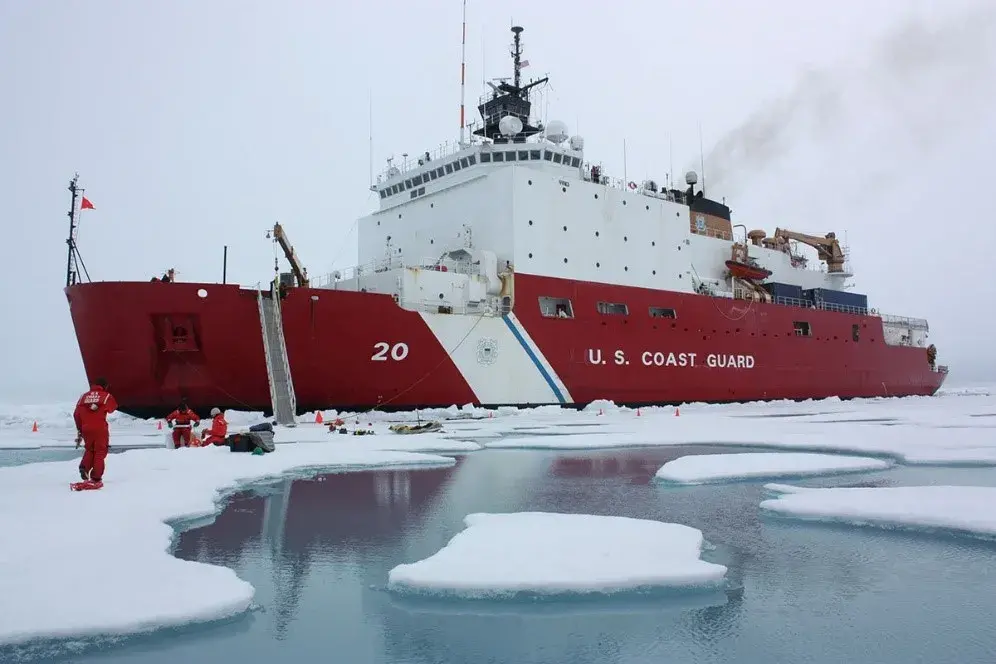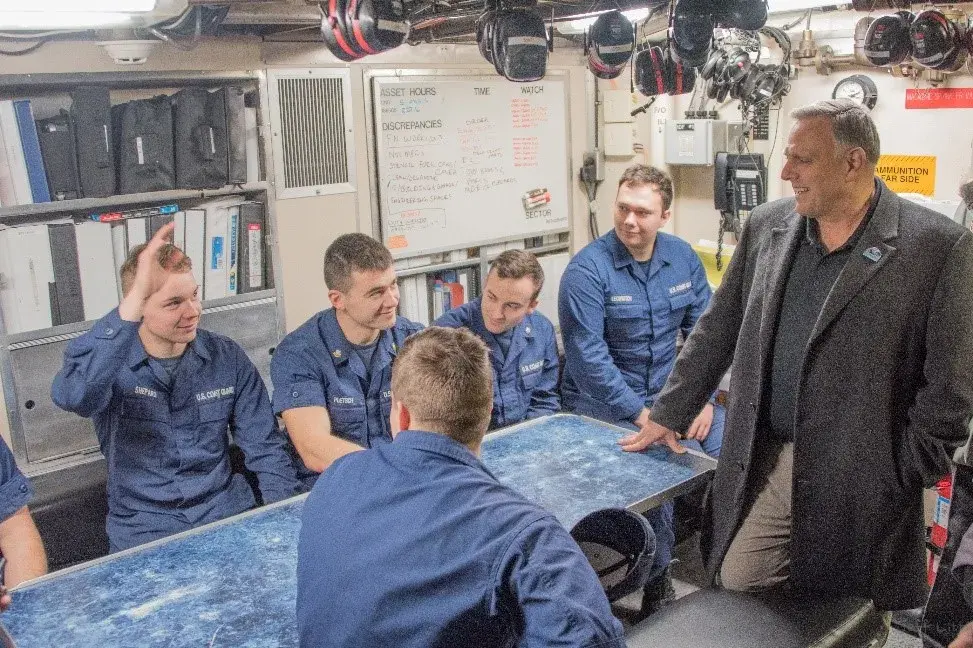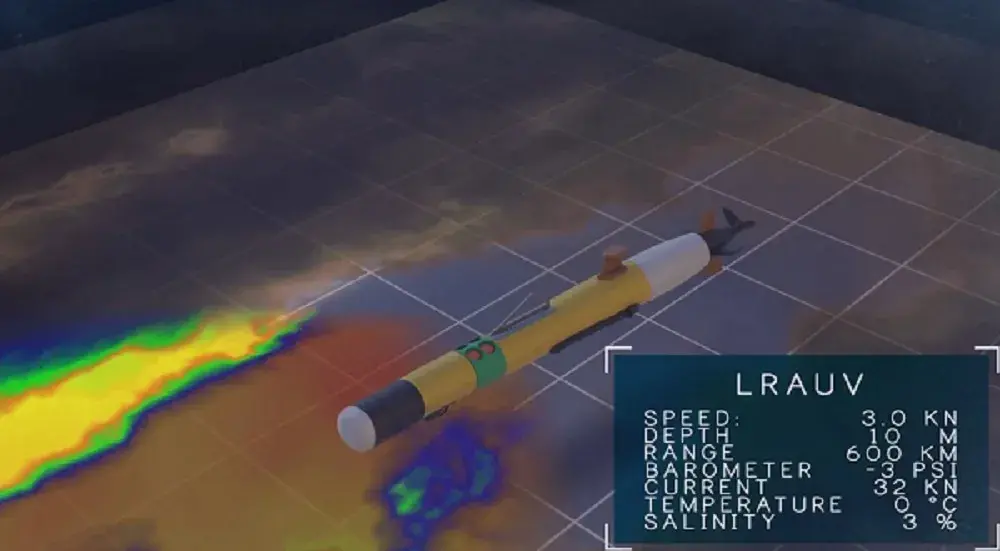In the great white-and-blue expanse of the Arctic with miles and miles of ice and water, harsh wind and waves, human contact is sparse. The population density of the Alaskan Arctic circle is less than one person per square mile. The breathtakingly beautiful Arctic Ocean presents obstacles for ships that dare to cross it, even for the guardians of the water realm – the U.S. Coast Guard (USCG).
 Changing ice conditions in the Arctic Ocean bring not only difficulties, but also present unique opportunities. Ever since becoming an Arctic Nation in 1867, the Arctic remains strategically vital to the United States. As sea ice melts more and more each year, new space opens up for international strategic competition for economic and geopolitical advantages.
Changing ice conditions in the Arctic Ocean bring not only difficulties, but also present unique opportunities. Ever since becoming an Arctic Nation in 1867, the Arctic remains strategically vital to the United States. As sea ice melts more and more each year, new space opens up for international strategic competition for economic and geopolitical advantages.
The Coast Guard grapples with ice conditions not only in the Arctic, but anywhere in the northern regions where bodies of water freeze in the winter. For officers patrolling northern Alaska, the Great Lakes and the northeastern stretches of the U.S., understanding the environment in the northern regions is key to overcoming the numerous challenges while on guard and responding to emergencies. The Department of Homeland Security (DHS) Science and Technology Directorate (S&T) tackles these challenges via the Arctic Domain Awareness Center (ADAC), a DHS Center of Excellence based at the University of Alaska Anchorage.
"Alaska's vastness, remoteness, and lack of infrastructure created enormous challenges for Coast Guard operators' efforts to communicate effectively and gain domain awareness – challenges that need to be addressed to strengthen the security and secure the future of the region,” said DHS Senior Official Performing the Duties of the Under Secretary for Science and Technology William Bryan, who paid a visit to ADAC in December 2019.
“The missions of the Coast Guard are continually evolving to meet the needs of a changing Arctic,” Mr. Bryan continued. “The visit allowed me to gain a deeper understanding of the ADAC research and education program, as well as the Coast Guard’s operational challenges and ADAC's engagement with key stakeholders.”
The ADAC mission
S&T established the ADAC Center of Excellence in 2014 specifically to support Coast Guard missions and the maritime community in the Arctic through research and development of specialized technology capabilities, knowledge products, and educational opportunities.
ADAC's mission is to improve maritime situational awareness and crisis response capabilities for search and rescue, humanitarian assistance, disaster response, and homeland security missions. The Center aims to develop and deliver technology solutions, innovative products and educational programs using a science-based approach. The results of these efforts also benefit ADAC’s partners and collaborators and support the public good.
“ADAC partners with other federal agencies and industry to transition products to the Coast Guard and Alaskan communities. For example, ADAC developed an arctic oil spill response model and transitioned it to the National Oceanic and Atmospheric Administration (NOAA) for inclusion into its General NOAA Operational Modeling Environment (GNOME), which USCG utilizes for various missions,” said Theophilos Gemelas, DHS S&T Program Manager overseeing the ADAC program. “NOAA is responsible for providing the Coast Guard with spill forecasts in the event of a marine oil spill.”
S&T's Bill Bryan pays a visit
 During his recent visit, Mr. Bryan took part in roundtable discussions with ADAC leadership, university leadership, students, federal, state and local officials working in Alaska, the indigenous community, and local industry leaders. Topics included ADAC efforts in innovative research and education, addressing challenges in collecting, integrating and interpreting data, as well as the need for infrastructure in the vast Arctic to help with emergency response. Participants noted the importance of data collection from sensors deployed in space, land, and maritime domains for a systematic understanding of the environment.
During his recent visit, Mr. Bryan took part in roundtable discussions with ADAC leadership, university leadership, students, federal, state and local officials working in Alaska, the indigenous community, and local industry leaders. Topics included ADAC efforts in innovative research and education, addressing challenges in collecting, integrating and interpreting data, as well as the need for infrastructure in the vast Arctic to help with emergency response. Participants noted the importance of data collection from sensors deployed in space, land, and maritime domains for a systematic understanding of the environment.
“ADAC has successfully fostered a network of Arctic operators, communities, researchers and public officials to explore solutions, particularly for the Coast Guard and other maritime stakeholders,” Mr. Bryan said.
Current ADAC projects
As part of the DHS S&T Centers of Excellence, S&T funds ADAC through its Office of University Programs to research solutions to challenges the Coast Guard faces in ice impacted areas. Here are some of the projects ADAC is working on.
Ice Conditions for the Great Lakes and the Arctic
Ice getting in the way of ships is a major issue for the Coast Guard servicing the Great Lakes. ADAC is developing an ice condition index (ICECON) tool to help with safe navigation and voyage. ICECON combines information on the classes of vessels in a given area at a given time with immediate lake ice conditions and five-day prognosis. For such prognoses, ICECON uses satellite information and NOAA circulation and ice models.
“ICECON is completing its integration into the U.S. National Ice Center, a multi-agency center operated by the U.S. Navy, the Coast Guard and NOAA, with data from the Canadian Operational Sea Ice Model,” said Gemelas. “This work will better help the Coast Guard minimize risks to mariners to keep them safe.”
ADAC is also developing a similar tool for the Arctic—Arctic Ice Condition Index (ARCTICE)—to support mariners in the U.S. Exclusive Economic Zone portion of the North American Arctic ocean (the Bering, Chukchi, and Beaufort Sea) where vessel traffic has increased. ARCTICE relates local ice conditions to the capabilities of a specific vessel class, which is delivered in graphical charts. This index will provide forecasts of ice conditions from 72 hours up to one month in advance.
Long Range Autonomous Underwater Vehicle
 With the increase of commercial marine activity in high latitudes, the risk of oil spills grows. Characterizing the extent of oil spills in ice-free waters is difficult, but it is even harder under ice. ADAC is developing a prototype high endurance submersible robotic system for mapping oil spills under ice called Long Range Autonomous Underwater Vehicle (LRAUV).
With the increase of commercial marine activity in high latitudes, the risk of oil spills grows. Characterizing the extent of oil spills in ice-free waters is difficult, but it is even harder under ice. ADAC is developing a prototype high endurance submersible robotic system for mapping oil spills under ice called Long Range Autonomous Underwater Vehicle (LRAUV).
The current prototype is portable and easily launched and recovered. It can communicate data on oil spills and other environmental hazards to distant Coast Guard outposts via satellites and strategically placed buoy antennas. LRAUV has been tested in the past years in the ice-free waters of Monterey Bay, CA; it was just tested under ice in Lake Bog, Maine in February 2020.
“The research team at Woods Hole Oceanographic Institute in Massachusetts is testing the system this year in the Arctic, off the north slope of Alaska,” Gemelas said. “Tests include launching and recovering the LRUAV under ice, and testing communication systems.”
Arctic All-Hazards GIS (Geographic Information System) Platform
This web-based geospatial tool addresses a demand, caused by the increased activity in the Arctic, for comprehensive domain awareness for Arctic operators. The goal is to provide the Coast Guard with an adaptable webGIS interface for displaying, informing, and disseminating data to users from various communities.
“Although many of our Arctic partners do not have robust communications or command and control systems, the Coast Guard has a critical need to gather as much Arctic information as possible, fuse and present it on a geographic display, and--most importantly--share it quickly with responders throughout the Arctic,” said Hank Blaney, USCG Maritime Domain Awareness policy analyst, serving as Project Champion for this project.
 Arctic Geofencing - Arctic Vessel Monitoring, Geofencing and Alert Awareness
Arctic Geofencing - Arctic Vessel Monitoring, Geofencing and Alert Awareness
Arctic Geofencing addresses the need to develop a monitoring system that determines whether vessels comply with environmental protection and conservation regulations or whether they impede subsistence marine hunting activities. It also monitors speed and sends speeding tickets.
“This capability will alert Coast Guard watch standers when vessels enter areas they shouldn’t be in and share that picture with other responders,” Blaney said, who serves as Project Champion for Arctic Geofencing as well. “We’re also hoping we can utilize this capability, not just in the Arctic, but in all areas where the Coast Guard operates.”
Future outlook
ADAC continues to address the ever-evolving challenges the Arctic presents – unpredictable weather, increased vessel traffic and the tyranny of distance. Projects focusing on increasing domain awareness, improving the Coast Guard’s ability to search and rescue, providing humanitarian assistance and responding to disasters are on the Center’s agenda. The next key focus area for ADAC will be new research projects that address Coast Guard needs related to crisis response, which are based on request for proposals and currently under a merit review process.
